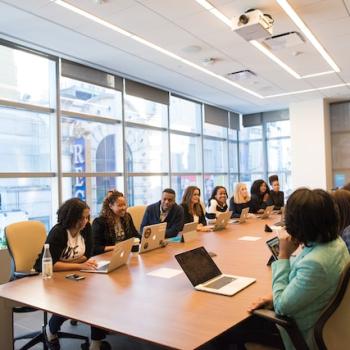
As we consider non-authoritarian ways of reading the Bible—as well as non-authoritarian ways of speaking in church, and more liberating ways of engaging with tradition—I also want to explore what non-authoritarian church structure and leadership could look like. In a wonky world of churchy authority, what does it look like to “authorize” ourselves?
“What Are You Authorized To Do?”
In my required leadership class in seminary, we had some guest lectures from a professor who was really into the idea of “authorization.” How do you make change in your church community? First, he said, you consider: “What am I authorized to do?”
At its best, I think this is a way of asking ourselves, Where do I have influence, and how can I use it? How can I see what power I have and use that power well? These can be good questions. They may offer a good alternative to fretting about the ways we don’t have influence or power.
At the same time, though, the way the guest lecturer talked about all of this struck me as casually authoritarian. There were a lot of assumptions behind what he was saying.
Who authorizes whom? I wondered. Where does authority come from? Is it really meant to function in a top-down way, where anyone who is not at the top of the churchy power hierarchy has to be very careful not to step out of place, for fear of ill-defined but very serious consequences?
And is there room for God’s Spirit of love and justice to do some authorizing directly, in ways that might surprise us—ways our human authority structures might not have thought of (and might not appreciate)?
I raised some of these issues in the class discussion forum. I think (at least some of) my classmates appreciated it. But I was the only one to do so.
Recycling Patriarchal Power
At the time, I felt a bit alone in questioning some of our guest professor’s assumptions about how authority does—and should—operate in churches.
But then I graduated from seminary. And I spent some focused time seeking out female authors and authors of color—the ones who were vastly underrepresented in my seminary curriculum. One of those authors was Sue Monk Kidd, who wrote (among many other things) The Dance of the Dissident Daughter: A Woman’s Journey from Christian Tradition to the Sacred Feminine.
Monk Kidd writes about women—so many of us women—who “had been severed from their feminine souls and because of that had learned to mimic the ways of patriarchy. What they mistook for female strength and authority was recycled patriarchal power.”
Recycled patriarchal power. What a striking image. And so true.
We are not free from patriarchy just because some of us women learn to operate within its authority structures and even hold power in these structures. Women can be in positions of authority—churchy or otherwise—but end up recreating the same toxic dynamics that have always marked those positions, rather than creating something new.
What does genuine “female strength and authority” look like? Surely, something vastly different from the “recycled patriarchal power” we keep seeing in our world—and in our faith communities.
The casually authoritarian assumptions of my (male) guest professor were being offered to male and female seminary students alike. Anyone can learn to operate within them—although women certainly face barriers to this that men do not. And, I hope, anyone can learn to do something different, something better.
From Being “Authorized” to “Authorizing” Ourselves
In The Dance of the Dissident Daughter, Monk Kidd goes on to write this: “We find genuine female authority within when we become the ‘author’ of our own identity. By taking the journey to the feminine soul, we ‘authorize’ ourselves.”
Monk Kidd initially wrote these words almost thirty years ago. But she could have been speaking directly to my guest professor in 2018.
When I read her words, I felt seen. I thought, yes, this is what we need to learn to do. This is what I need to learn to do.
Many of us don’t need to worry so much about what we are or are not “authorized” to do within existing authority structures. Personally, I think I tend to worry too much about this—so concerned about overstepping that I sometimes don’t step at all.
Instead, many of us—especially women, and people of color, and queer folks, and anyone else who has found that existing authority structures are often not terribly excited to “authorize” them with much of anything—need to learn to claim this authority for ourselves. We need to learn to “authorize” ourselves.
We don’t need to wait for someone else to tell us that our ideas are good ones, that our intuitions are spot-on, that the new things we want to try are worth trying, that the change we want to see is deeply needed. We know these things.
We have authority within ourselves to do what we think is right. To take the next faithful step. To step up, and step out, and try something new and uncertain. To lead, to grow, to influence.
This is one way we push back on the authoritarian tendencies of many church leadership structures. Instead of looking for someone to “authorize” us,” we learn to “authorize” ourselves.
















